Part 3 Not much of a ride report, a bit more Michael Palin.
We’d pressed on late into the day to get close to the border crossing at Vyartisilia. It didn’t help that it had taken ages to find a wild camping spot. The one we found wasn’t ideal - there wasn’t much room between the pines, the forest floor was covered in fallen cones, twigs and branches and the mossy ground was too soft to hold tent pegs firmly. We’d just got the tents set up when the heavens opened. All night long there was thunder and lightning, and it was still tipping down when we packed up our sodden tents and set off on the short ride to Russia.
Els had planned only 60 km for the day, because we didn’t know how long the border formalities would take. So there was no debate about diving into a transport cafe on the outskirts of Kitee.

Alternately we looked out at the falling rain and the weather forecast on Finnish breakfast TV, which we couldn’t decipher, even with several chances to view the graphics. We decided to leave when it stopped raining or 9:30, whichever was earlier. A tweet from a Finnish contact suggested it would be 9:30
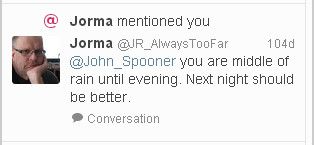
We might not have left strictly on the dot at 9:30, but eventually got under way again. About 10km further there was another roadside cafe, and we agreed that it was probably time for an early lunch. Even allowing time to digest the tasty schnitzel, followed by cake and coffee, it was still before midday when we reached the border. Finnish formalities took very little time, and, after an initial show of passports to an official in combat gear, we found ourselves standing in the rain at the back of line of cars. Soon the man in the front car saw us and took pity on us, waving us through.
First we were given tiny (about A6) forms to fill in. Using my Brooks to rest on, and struggling to fit everything into the minute spaces on the form, my soggy hands soon turned mine into little more than a smudged soggy mess. Els was first to present her documents to the large unsmiling blonde behind the window. Everything was checked - visa details were compared with passport details, ultra violet revealed no signs of forgery, details were entered into computer, and the passport was stamped - and after about ten minutes Els passed into Russia.
Then it was my turn. The lady went through the same procedure, until it came to using the ultra-violet machine. With furrowed brow she picked up her phone and spoke (it didn’t have a dial or keypad). A few seconds later two men in big hats came running from a different building.

They didn’t look too pleased to be dragged away from their samovar, but dealt fairly speedily with whatever had irked Svetlana and returned to the crossword in that morning’s Правда. I didn’t know what the problem was, but just stood there patiently - I knew everything would be sorted out eventually (despite the white lies on my visa application, which bizarrely as things turned out turned out to be true). Meanwhile all sorts of thoughts were running through Els’ head. What if, having let her in, they refused me entry? But in the end my stamped passport was returned to me and reunited, we got going into Karelia.
So far on our trip from Belgium to Finland we’d barely noticed any changes when going from one country to the next. A change of currency, perhaps, slightly different standards of cyclepath, or shop opening hours. But entering into Russia I experienced the same degree of culture shock as when getting off a plane at Bamako or Nouakchott. There seemed to be a general air of neglect. The road had not potholes but craters, which is why a car was coming towards us on the wrong side of the road - it was circumnavigating a few square metres of missing tarmac. Buildings looked tatty and neglected (especially so after the spick-and-spannness of Scandinavia). Grassy areas were overgrown. Still, it had stopped raining.
Els had picked out a hotel 10 km or so to the south-west, and we found this easily along a muddy track through a timberyard. It contrasted with what I’d seen so far (admittedly a very short time) in Russia. New, clean with well-tended lawns outside

and inside: clean*, nicely decorated, wifi and a receptionist who spoke English. By mid afternoon the sun came out and we were able to drape our tents over the balcony and dry them out.
*except under the stairs where we parked our muddy bikes.
Opposite was a lake, obviously an attraction for the oligarchs from St Petersburg who might wish to spend the weekend here and indulge in a little fishing when they had tired of speedboating.
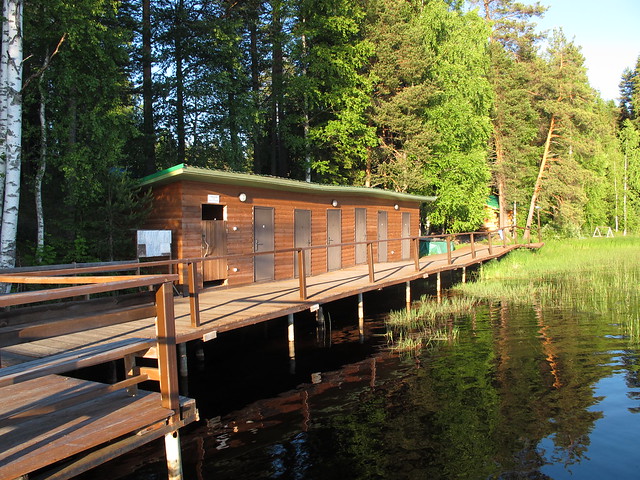


The restaurant building was new, but I couldn’t help comparing the decor and lighting with the restaurants I’d visited in East Germany in the 1970s. But the food was excellent, even if we couldn’t make head or tail of the menu, printed in the script form of Cyrillic. But with the patient help of the waitress, we got a good meal.

We set off early the next day, with the lake on our right, hoping that the muddy sandy track would soon give way to a road of tarmac or of compacted gravel as we had ridden on in rural Sweden and Finland. The rain didn’t help. There were few other road users Occasionally we heard the rumble of an approaching timber truck. That was a cue to pull over into the undergrowth and watch the truck thunder past, its unladen trailer bouncing about on the uneven surface. It was difficult to keep the bike going in a straight line on the slippery mud and brakes became caked with mud, producing a horrible scraping sound. On flat bits my 32s sank into the wet sandy mud. We ended up pushing our bikes up the hills, and descending slowly for fear of ending up in one of the ruts down which the water was streaming. Bridges across rivers were constructed of logs.

The tarmac never appeared. By 11:30 we had covered about 25 km. It was clear we wouldn’t do anything like the 150 km we had planned. And if the planned route to Kem was all, or mostly, on such roads as this there would be no possibility of getting there with enough time to visit Solovki. Besides which we weren’t carrying much food, and couldn’t be sure of anywhere to stock up with more.
So with a tinge of sadness we realised that cycling all the way was out of the question and made the decision to return to the hotel and come up with a Plan B (or Plan Bee as my sister pointed out). The return trip was a long slog, but when we reached the hotel Els swung into action to plan the rest of our trip. We’d lost a day so a radical rethink was required. It was only a small obstacle that today’s receptionist didn’t speak English when Els sought her advice - they communicated via google translate, taking turns to type into the hotel PC. The receptionist didn’t seem to have much local knowledge, so roped in the cleaning lady for route advice. I just sat back and waited for this ad hoc committee to come up with a plan. Els also phoned her contact Dimitri, who turned out to be very helpful and provided priceless route advice and train info.
Eventually a plan formed. We would ride south 70 km to the nearest station, in the town of Sortavala, get the train from there to St Petersburg, and then get the train to Kem. From Kem the ferry would take us to Solovki. And then do it reverse, with Els flying home from St Pete’s and me going to Sortavala to pick my bike up and head home from there. Simple. I had no doubt that over the next few days we’d have to tear up plan B and come up with plans C, D, and E or as many as it took until we ran out of letters.
Next day we retraced almost to the border, then took the main road to Sortavala. This had a pretty good surface. In fact in places where fresh asphalt had been applied, there was a big drop off to the side and both of us sensed possibly disastrous consequences if we rode off the road.
We reached Sortavala in good time, stopping only at what was obviously a local beauty spot with several waterfalls, although Els was more interested in the stall selling honey

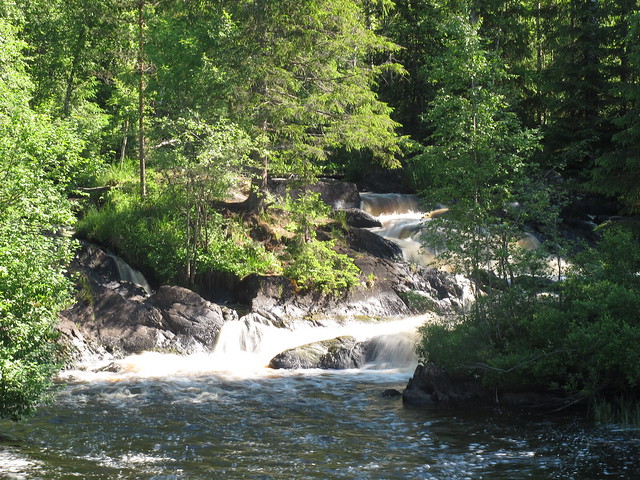
Sortavala was hot and dusty. The smell reminded me of some African towns I had visited.

We went straight to the station to sort out tickets for the rest of the journey. While Els went into the booking hall I read a book, rewired my rear light, adjusted my brakes, read a book again, looked up hotel details, provided Els with my passport and a few thousand roubles (they only took cash and luckily I’d stopped at a cashpoint). It must have been well over an hour before Els emerged once more brandishing a stack of tickets. And what magnificent tickets they were

We managed to check in at the Hotel Lagoda (as recommended by DImitri), a hotel built in the 1930s and seldom decorated since. Lovely decaying elegance. We packed up Els’ bike for the train journey - wheels off, and wrapped in my tarp, aided by the hotel security guard, who appeared not to refrain from the odd vodka while on duty (my bike was to stay at Sortavala), then went for a walk into town. There were lots of old wooden buildings, similar to those we had seen in the Finnish towns Turku and Porvoo. That really isn’t that surprising, as Sortavala was part of Finland until the Winter War 1939-40, changed hands a couple of times during the Continuation War 1941-44, and ended up part of the Soviet Union.
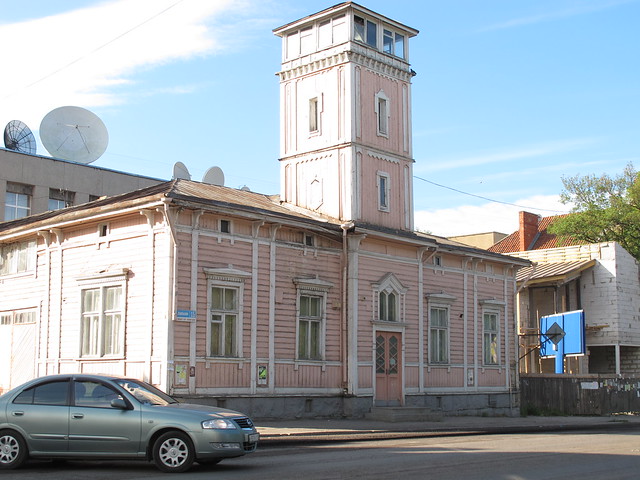

They also had a statue of Wowbagger
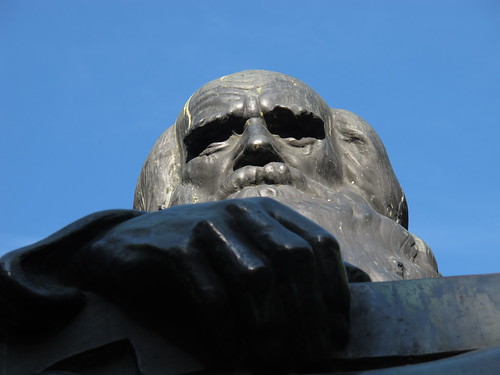
I also had to make arrangements for leaving my bike and camping gear in Sortavala while we went to St Petersburg and beyond. Armed with notebook and phrase book I went to reception - the receptionist didn’t speak English, but my first request to book a room for the 22nd was easily understood and flatly refused. There was a car rally on that weekend and there wasn’t a room to be had for miles around. Somehow I managed to explain it wasn’t a problem - I had a tent. Then after a lengthy sign language conversation, numerous misunderstandings and plenty of laughter, I arranged for my luggage to be stored in a downstairs store room and my bike to be left in the car park behind the hotel. I wasn’t particularly happy with that, so borrowed Els’ new lock, and covered the bike with her groundsheet, so it wouldn’t be immediately obvious what it was.
Next morning a taxi got us to the station in good time. It was less than a kilometre away but we had an unweildy wrapped-up bike, panniers and barbags to carry, so played safe. The train rolled slowly into the station bang on time, and we found the coach where our booked ‘seats’ were, showing tickets and passports to the stone-faced provodnitsa (carriage attendant) as we boarded. I was expecting a normal train carriage - with seats, possibly tables, that sort of thing. But no, this was a sleeper, and everyone was still asleep. It looked very much like
this.
I found my allocated bunk, which was a top bunk, but after stashing our luggage had great difficulty in getting up to it. There were a couple of footholds, but the headroom was tiny. With a most inelegant manoeuvre I managed to haul myself up and wriggle onto it, but I’m glad no-one was awake to see me. I wondered how Els was getting on with her bicycle-shaped package. (As it happens, people were very helpful in re-arranging their luggage to make room). It was several hours before we would reach St Petersburg, so I fired up my e-reader and got stuck into a bit of Dostoyevsky. I wanted to look at the scenery, but the bunk only just above the top of the window, so it was with great difficulty that I got a view. When I did manage to distort my neck enough to see anything, the view could be summed up in one word. Trees. Or in three words, lots of trees, or alternatively, nothing but trees.
No-one stirred until mid-morning, except the woman on the lower of the bunks opposite me, who got up from time to time to stroke her husband’s ample stomach, as this was obviously a proven method of stilling his snoring. The usual procedure on waking was to visit the samovar at the end of the carriage and return with a glass of tea, wrap up the sheets and mattress, and then sit on the bottom seat.
The train rolled and clanked into St Petersburg on time, and we took a taxi to the hotel Els had booked for her return trip. The taxi ride was notable for two things - we were taken along
Nevsky Prospekt, and the taxi driver couldn’t find the hotel, despite having the address and a satnav. When at length we got there, I stayed outside while Els went in to get a room sorted. It was ages before she re-emerged. She had initially been told that it was full, so she just stood there until they magically remembered a cancellation. Any other hotel would have been less than ideal because Els wanted to leave her bike and camping stuff there while we went off to Solovki. It was clear that Els was going to make Plan B(ee) work even if it didn’t want to.
It also meant that I’d be staying at the hotel which I’d specified on my visa application, even though I’d had no intention of going to St Petersburg when I filled it in. I’d have a voucher from the hotel saying I’d been there, so that was a little inconsistency I wouldn’t have to explain away if I was required to show my papers anywhere.
Els packing her bike for storage:


At one point in the afternoon I lazily looked at our schedule and wondered out loud how we were going to get to the hotel from the station at Kem, given that we wouldn’t arrive until 00:46, the hotel was 12 km away, and as we hadn’t booked, would there be anyone there to give us a room? I assumed, given Els’ efficiency, that it was all sorted, and I'd get an answer. In reply there was a “Hmph!” from Els, and she was straight onto her iPad, and an email was fired off to the hotel. In time the answer came back - taxi from outside the station, it’ll cost 300 roubles, and we’ll reserve a room for you.
Now being seasoned veterans of Russian rail travel, we had a bit more of an idea of what to expect for the next day’s 14-hour journey. This time we had opposite top bunks, so could chat, and had stocked up with plenty of food. Rather than snacking at indeterminate times during the day, we decided to eat at definite mealtimes. Our journey also demonstrated something we had suspected on our first journey: as soon as Russians get on a train, they sleep. The woman on the bunk below Els got on at St Petersburg at 9:30 am, immediately changed into her pyjamas, made up her bed, and went to sleep. Apart from a few breaks from her slumbers to do a puzzle in her wordsearch book or to eat a biscuit, she slept all the way to Kem (and didn’t get off there, so presumably slept all the way to Murmansk).

And yes, madam, your bum does look big in that.
Meanwhile, I read some more Dostoyevsky, listened to some podcasts, slept a little and watched the trees go by. Els read and slept.
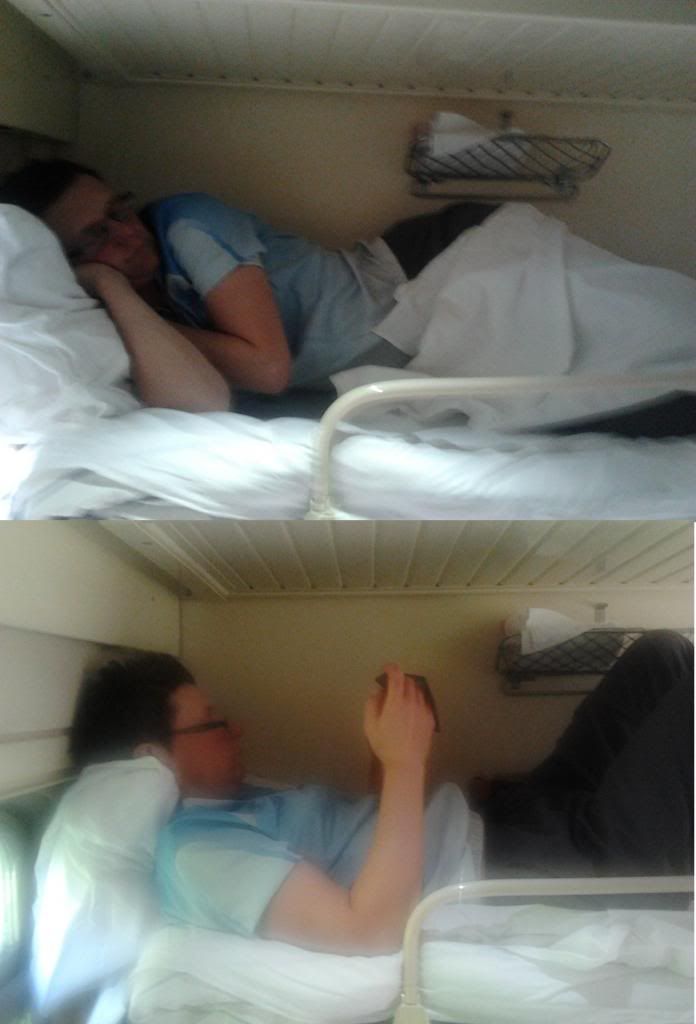
The view from my bunk

Our provodnitsa made sure we were ready to get off when we reached Kem, and we staggered off the train into the northern midsummer post-midnight twilight. We were about 150km south of the arctic circle and the sun had set, but it was the sort of half-light which, if I was riding my bike back home, would prompt the thought that perhaps I should maybe start thinking about putting my lights on soon. Dimitri (or was it Vladimir?) had warned us to have plenty of cash so we got the taxi to take us via an ATM (one of the few in that part of Russia - I had done my homework). The taxi was rather bizarrely decorated, and the driver spent most of the journey on her phone, but we were dropped off outside the hotel (a complex of log buildings), with instructions to get to the reception buildings. We saw some people sitting outside one of the buildings, and seeing us a woman got up and said “Ah, you must be Els.” She briskly whisked us inside, got her staff to check us in, do the police-registration stuff, sold us tickets on the first ferry the following morning, and showed us to out room. We also met Anatoli, who’d be on the ferry as well.
Before 8 the next morning the same woman was standing on the ferry’s gangplank, giving a lengthy speech to the assembled passengers in Russian. It went on for several minutes. I’ve no idea what it was all about, but her English summary for our benefit was “Mind how you go, it’s a bit slippery”.
Most passenger were in the saloon, many of them fast asleep.


The White Sea was very foggy, and after a couple of hours the "Vasiliy Kosyakov" slowed down to a crawl. I learned later that the approach is very rocky, and there is a very narrow channel marked by bouys, before two markers appear on a hill above the jetty which have to be lined up if you don’t want to hit the submerged rocks. If you miss the first bouys, you're in trouble. I showed Anatoli the track on my Garmin. He was very impressed, and suggested I should lend it to the captain.
Two and a half hours later the island loomed out of the fog, and for the first time we caught sight of the monastery’s impressive array of towers.

I could tell this was an important moment for Els. In 2011 her Dad had told me about her long-standing wish to cycle to the islands, the home of St Zosimas the beekeeper. The tone of his voice suggested it was a wild idea (what a crazy daughter I have!), but it immediately struck me as a brilliant idea for a jaunt. Anyway, we were nearly there, even though it hadn’t gone quite to plan. Several times since arriving in Russia, as a leg of the revised plan had been completed successfully, we’d looked at each other as if to say “You know, we might actually get there!”, and now we could see it through the fog with our very own eyes. The first part of Plan B(ee) had actually worked.

To bee continued.